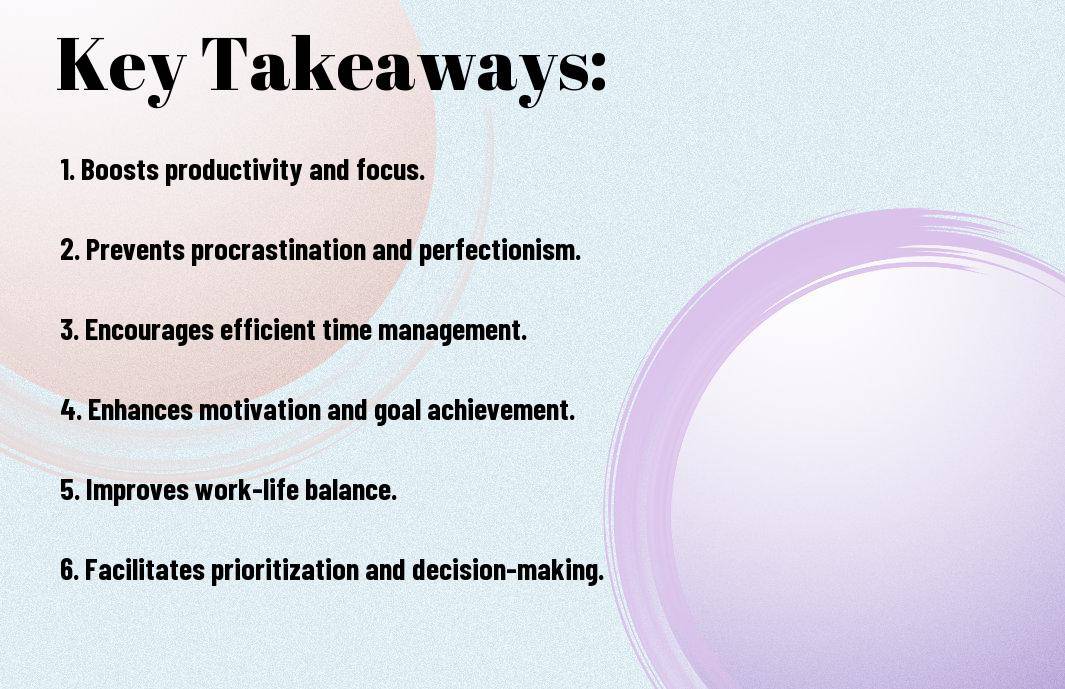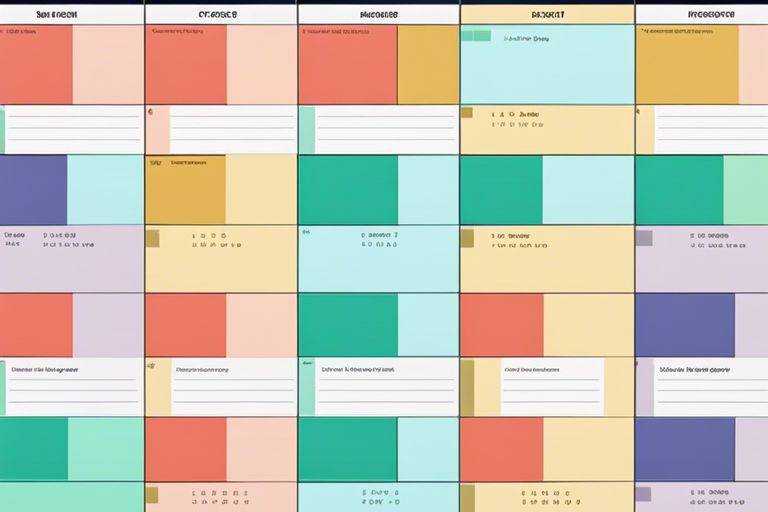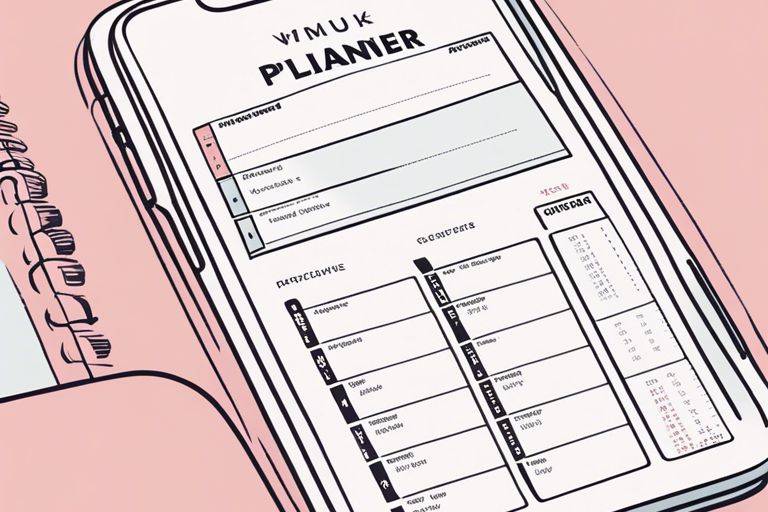Overwhelmed by never-ending to-do lists and feeling like there are never enough hours in the day? Timeboxing might just be the solution you need. This time management technique involves setting specific time limits for each task, helping to enhance focus, increase productivity, and avoid procrastination.
By breaking down your work into manageable chunks with designated timeframes, you can maximize efficiency, reduce decision fatigue, and improve time management skills. Whether you’re a student trying to study more effectively, a professional aiming to meet deadlines, or simply someone looking to better allocate their time, timeboxing can revolutionize the way you approach tasks and boost your overall productivity.
Key Takeaways:
- Enhances focus: Timeboxing helps in avoiding distractions and enables individuals to concentrate fully on the task at hand.
- Increases productivity: Setting time limits on tasks creates a sense of urgency, leading to more efficient work output.
- Encourages prioritization: It promotes the identification of crucial tasks and ensures they are completed within the allocated time frame.
- Improves time management skills: By practicing timeboxing, individuals learn to estimate the time needed for various activities and allocate time accordingly.
- Reduces procrastination: Having a set time limit adds a sense of discipline and can help combat the tendency to procrastinate on tasks.
- Enhances work-life balance: By limiting the time spent on work tasks, employees can allocate time for personal activities, leading to a better balance between work and life.
- Promotes creativity: Constraints imposed by timeboxing can stimulate creative thinking and problem-solving as individuals strive to meet deadlines with innovative solutions.


The Principles of Timeboxing
The Fundamental Concept
Some individuals might find the concept of timeboxing to be restrictive at first glance. However, it is important to understand that timeboxing is not about limiting creativity or productivity, but rather about enhancing focus and efficiency. By setting specified time limits for tasks, individuals are compelled to prioritize, make decisions quickly, and avoid procrastination.
Benefits of Timeboxing
Any individual looking to improve their time management skills should consider implementing timeboxing into their routine. One of the key benefits of timeboxing is the sense of urgency it creates. Knowing that there is a time limit on a task can help individuals concentrate better and accomplish more in a shorter period. Additionally, timeboxing can help prevent overworking and burnout by promoting regular breaks and a healthier work-life balance.
Timeboxing can also encourage individuals to break down large tasks into smaller, more manageable chunks, leading to a sense of accomplishment with each completed timebox. This approach can increase motivation and satisfaction in completing tasks, resulting in a more positive outlook on daily responsibilities.
Common Misconceptions
Principles
Any misconception that timeboxing limits creativity or restricts flexibility is unfounded. The purpose of timeboxing is not to stifle creativity, but to enhance it by providing structure and focus. By allocating specific timeframes to work on tasks, individuals can allocate dedicated time for brainstorming and exploration, while still ensuring progress is made within set limits.
Concept
This concept of timeboxing might seem rigid to some, but it is necessary to understand that the freedom within constraints can lead to increased productivity and efficiency. By embracing the limitations of timeboxing, individuals can experience a greater sense of accomplishment and control over their daily tasks, ultimately leading to improved time management skills and overall work performance.
Implementing Timeboxing in Daily Life
Identifying Tasks Suitable for Timeboxing
Many individuals struggle with managing their time effectively, leading to procrastination and inefficiency. When implementing timeboxing in daily life, it is crucial to identify tasks that are suitable for this time management technique. Tasks that are specific, measurable, and have a clear start and end point are ideal candidates for timeboxing.
Estimating Time Requirements
Daily estimation of time requirements for tasks is important in effective timeboxing. The ability to accurately gauge how long each task will take helps in allocating appropriate time slots. The estimation process may require some trial and error initially, but over time, individuals can develop a better understanding of their productivity levels.
The more accurate the time estimates, the more effectively one can plan their day and ensure tasks are completed within the time constraints set by the timebox.
Setting Up a Timebox Structure
This subsection focuses on establishing a framework for timeboxing in daily routines. Setting up a timebox structure involves determining the duration of each timebox, scheduling breaks in between, and prioritizing tasks based on importance and urgency. A well-structured timebox can help individuals stay focused, avoid distractions, and maintain momentum throughout the day.
Timeboxing can be implemented in various aspects of daily life, including work projects, household chores, and personal activities. By setting clear boundaries and time limits for each task, individuals can enhance their productivity and time management skills.
Tools and Resources
Identifying the right tools and resources to support timeboxing is crucial for its successful implementation. Time tracking apps, online calendars, and task management platforms are valuable resources that can aid in organizing and monitoring timeboxing activities. These tools provide a visual representation of tasks, deadlines, and time allocations, helping individuals stay on track and adjust their schedules accordingly.
The use of time management tools not only facilitates the implementation of timeboxing but also promotes accountability and efficiency in daily tasks. By leveraging these resources, individuals can maximize their time and accomplish more in a structured and organized manner.

Timeboxing in a Work Environment
Now, timeboxing is a highly effective technique for managing time and tasks in a work environment. By allocating specific time frames to tasks, individuals and teams can enhance their productivity, focus, and efficiency.
Enhancing Productivity in the Workplace
An crucial aspect of timeboxing in the workplace is the ability to prioritize tasks effectively. By setting time limits for each job, employees are encouraged to concentrate on the most critical tasks at hand. This focus helps in avoiding distractions, multitasking, and procrastination, leading to increased productivity levels.
Adapting Timeboxing for Teams
On a team level, adopting timeboxing can help synchronize efforts and ensure everyone is aligned towards common goals. Assigning time frames for group discussions, brainstorming sessions, and collaborative tasks can foster better communication, decision-making, and teamwork among team members.
Another advantage of implementing timeboxing for teams is the facilitation of regular progress checks. By breaking down projects into smaller tasks with set time limits, teams can track their progress more effectively and make necessary adjustments to stay on schedule.
Timeboxing for Project Management
Work breakdown structure combined with timeboxing serves as a powerful tool in project management. Project managers can divide complex projects into manageable tasks and assign specific time frames for their completion. This approach not only helps in meeting deadlines but also in identifying potential bottlenecks and resource constraints in advance.
To ensure successful project execution, project managers must regularly monitor and adjust timeboxes based on the progress of tasks. This dynamic approach allows for flexibility while ensuring the overall project stays on track.
Overcoming Resistance in Organizational Culture
Workplace culture plays a significant role in the successful implementation of timeboxing. To overcome resistance in organizational culture, it is crucial to educate employees on the benefits of timeboxing, including improved time management, increased efficiency, and reduced stress levels.
Understanding the importance of buy-in from key stakeholders and leadership can help in promoting a culture that values effective time management practices such as timeboxing. By fostering a culture that embraces timeboxing, organizations can enhance their overall productivity and project success rates.
Advanced Timeboxing Techniques
- The Pomodoro Technique
With the Pomodoro Technique, you break your workday into intervals, traditionally 25 minutes of focused work followed by a 5-minute break. After completing four intervals, you take a longer break of 15-30 minutes. This technique helps maintain focus and productivity by giving your brain regular breaks to recharge.
Customizing Timeboxing Approaches
For those looking to tailor their timeboxing methods to their specific needs, customizing timeboxing approaches can be highly beneficial. By adjusting the length of work intervals and breaks, individuals can optimize their productivity levels and maintain motivation throughout the day.
Pomodoro: Some may find that the traditional 25/5 Pomodoro intervals are not suitable for their work style. Customizing the length of work intervals can help individuals find the optimal balance between focus and energy levels, leading to improved efficiency.
Combining Timeboxing with Other Productivity Methods
With the combination of timeboxing and other productivity methods such as the Eisenhower Matrix or the Getting Things Done (GTD) system, individuals can enhance their overall productivity and organization. By integrating timeboxing with these strategies, individuals can prioritize tasks effectively and ensure that their time is allocated efficiently.
The effectiveness of timeboxing lies in its ability to provide structure and focus to your workday. By utilizing advanced timeboxing techniques and customizing your approach to suit your individual preferences, you can maximize productivity and achieve your goals with efficiency.
Timeboxing for Personal Development
All of us aspire for personal growth and development. Timeboxing is a technique that can be incredibly useful in this journey. By allocating specific timeframes to focus on different areas of personal development, individuals can make significant progress in achieving their goals.
Timeboxing for Learning New Skills
Learning new skills is necessary for personal growth and career advancement. Timeboxing can be an effective strategy for incorporating learning into your daily routine. By dedicating a set amount of time each day or week to acquiring new skills, you can make consistent progress over time. Whether it’s learning a new language, mastering a musical instrument, or acquiring technical skills, timeboxing can help you stay disciplined and motivated.
Timeboxing for Health and Exercise
Development of both mind and body is crucial for overall well-being. Timeboxing can be a game-changer when it comes to prioritizing your health and fitness goals. By setting aside dedicated time for exercise, meal prepping, and self-care activities, you can ensure that your physical and mental health remains a top priority. Incorporating timeboxing into your routine can help you stay on track with your health goals and lead a more balanced lifestyle.
Timeboxing for personal development involves setting aside dedicated time each day or week for activities that contribute to your growth and well-being. By allocating specific timeframes to learning new skills, prioritizing health and exercise, managing creativity, and practicing effective time management, individuals can make significant progress towards their personal development goals.
Time Management for Creativity
Creativity requires time, space, and discipline to flourish. Time management is a crucial aspect of nurturing creativity. By setting aside uninterrupted blocks of time for creative pursuits, individuals can explore deep into their creative process and produce impactful work. Timeboxing can help prevent procrastination and distractions, allowing for more focused and productive creative sessions.
Plus, incorporating timeboxing into your creative routine can help you establish a rhythm and routine that supports your artistic endeavors. By dedicating specific time slots for brainstorming, ideation, and creation, you can enhance your creative output and bring your ideas to life more effectively.

Challenges and Solutions in Timeboxing
Dealing with Interruptions and Distractions
Keep in mind that interruptions and distractions are inevitable in any work environment. These can derail your timeboxed tasks and lead to inefficiency. To combat this, designate specific time slots for checking emails, attending meetings, or addressing unexpected issues. By being disciplined and sticking to your allotted time for these interruptions, you can ensure that they don’t consume your entire day.
Adjusting When Things Don’t Go as Planned
For any timeboxing strategy, flexibility is key. Sometimes tasks may take longer than expected, or you may encounter unforeseen obstacles. Any experienced timeboxer knows that adaptability is crucial. When faced with delays, assess the priority of your tasks and adjust your timeboxing accordingly. Consider allocating extra time for unforeseen circumstances in future timeboxing sessions.
When things don’t go as planned, it’s important to review and learn from the situation. Reflect on what caused the delays and consider how you can better estimate time for future tasks. By continuously improving your timeboxing skills, you can enhance your overall productivity and efficiency.
Scaling Timeboxing for Complex Tasks
Things can get more complicated when timeboxing complex tasks. Breaking down these tasks into smaller, more manageable sub-tasks can help. Create a detailed plan with clear milestones and deadlines to stay on track. Allocate specific timeframes for each sub-task, ensuring that you are making steady progress towards the overall goal.
With complex tasks, it’s vital to prioritize and focus on the most critical aspects first. By tackling the most important parts early on, you can ensure that even if unexpected delays occur, the core objectives are still met. Applying timeboxing to complex tasks requires a strategic approach and a commitment to staying organized and focused.
Final Words
As a reminder, timeboxing is a powerful technique for managing time efficiently and increasing productivity. By setting specific time limits for tasks, individuals can improve focus, prioritize effectively, and make better use of their time. To dive deeper into timeboxing and learn more about this effective time management strategy, check out Timeboxing – The Complete Guide.
FAQ
Q: What is Timeboxing?
A: Timeboxing is a time management technique that involves assigning a fixed amount of time to a task or activity.
Q: How does Timeboxing work?
A: With Timeboxing, you set specific time limits for each task, focusing solely on that task during the allocated time frame.
Q: What are the benefits of Timeboxing?
A: Timeboxing helps increase productivity, improves focus and concentration, and reduces procrastination by creating a sense of urgency.
Q: How can I implement Timeboxing in my daily routine?
A: Start by identifying tasks that need to be completed and assigning specific time blocks to work on them. Use tools like timers or apps to track your progress.
Q: What happens if I don’t finish a task within the allocated time box?
A: If you don’t complete a task within the set time frame, you can either extend the time box slightly or reassess the task’s urgency and importance for rescheduling.
Q: Can Timeboxing be used for all types of tasks?
A: Timeboxing is effective for various tasks, from work projects and studying to household chores and personal goals. It can be adapted to suit different activities and priorities.
Q: How can Timeboxing help in managing stress and achieving work-life balance?
A: By setting boundaries on how much time you spend on tasks, Timeboxing helps prevent burnout, allows for better prioritization of activities, and promotes a healthy balance between work and personal life.
Dive Deeper Into The Ideas Of Productivity
Getting Things Done (GTD) – David Allen’s System to Efficiently Organize and Prioritize Tasks
80/20 Rule (Pareto Principle) – Vilfredo Pareto’s Technique to Focus on High-Yield Tasks
Eisenhower Matrix – Dwight D. Eisenhower’s Strategy to Prioritize Tasks by Urgency and Importance
Biological Prime Time – Scheduling Tasks When Energy Is Highest for Peak Productivity
Deep Work – Cal Newport’s Secrets to Maximizing Focus on Demanding Tasks



